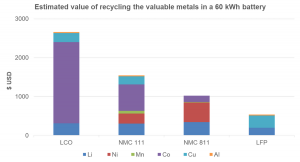A recent report by market analyst IDTechEx estimates that 2020 will see 330 kt of waste Li-ion battery and, thus, forecasts a growth in the recycling market.
According to the document, most of the waste will derive from consumer electronics. However, it is the sheer volume of end-of-life electric vehicle batteries which will be problematic if not properly dealt with.
“For the lithium-cobalt-oxide batteries used in the vast majority of consumer devices, the intrinsic value is relatively high, and recycling can be profitable from recovering cobalt and copper alone. Indeed, old consumer electronics could be a significant source of cobalt in the short-medium term, though hoarding, collection and distribution challenges make this unlikely,” the report reads. “EV batteries on the other hand will be easier to track, collect and manage. However, the material value in an EV battery, on a $/kg basis, is lower due to the smaller amounts of cobalt used per kWh – and manufacturers are aiming to further reduce cobalt content, and even reduce nickel content further down the line.”

Despite the challenges, IDTechEx has tracked numerous companies that are now developing and commercializing various recycling processes, and combinations thereof, to recover more material from Li-ion cells in order to capture as much value as possible.
“Ensuring proper end-of-life management, for example via recycling, and using recycled material can help reduce energy and material requirements throughout the manufacturing chain and could help present companies with a marketing advantage,” the analysis states.
In IDTechEx’s view, the opportunities that recycling opens particularly in the case of Europe and the United States are not to be dismissed, particularly because these regions are actively seeking to develop a domestic supply of critical materials, including those present in Li-ion batteries.
“While the US is home to some key material resources such as graphite and lithium, Europe is resource-poor. Recycling, of manufacturing scrap or end-of-life batteries, could therefore be a key resource allowing for some diversification of supply,” the paper reads.
